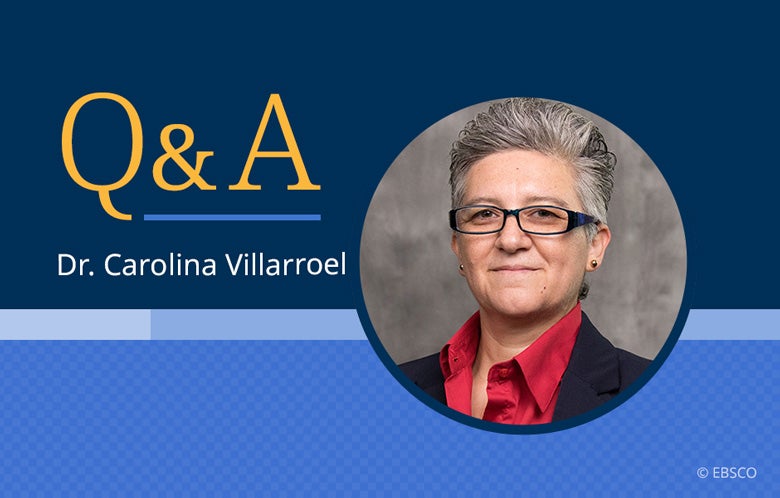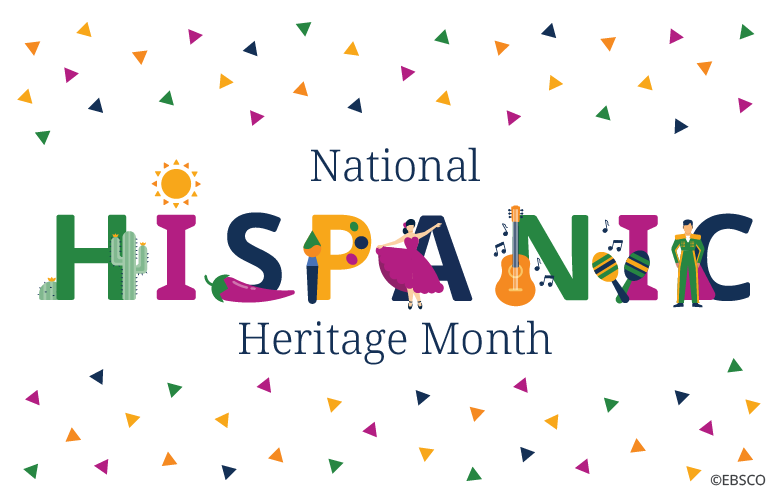As the Brown Foundation Director of Research for Recovering the US Hispanic Literary Heritage Program at the University of Houston, Dr. Villarroel and the Recovery team are dedicated to preserving and making available the written legacy of Latinas and Latinos in the US and creating digital repositories and projects. Recovery is a subsidiary program of Arte Público Press, the publisher of historical and contemporary works by Latina and Latino authors focusing on Hispanic culture, which are searchable in EBSCO’s Arte Público Hispanic Historical Collection Series 1 & 2 databases.
Q: Why is it important to have a special month dedicated to Hispanic heritage and history?
A: It’s important because we need spaces for minorities to tell our stories and share our history. Often our communities don’t see themselves reflected in an accurate way in media outlets. It’s important to have a public space to showcase our community’s diversity and to have an opportunity to represent ourselves. It’s not just about our food and the festivities we celebrate, we need an opportunity to show our complexities and richness, to go deeper into what it means to be Latinos/as today and having a month to highlight all of that is important.
Q: What does Hispanic Heritage Month mean to you and the Arte Público Press organization?
A: The mission of Arte Público Press is to provide publishing spaces for Latinas and Latinos in the United States and also, with its historical component, Recovering the US Hispanic Literary Heritage Program, to preserve and make available the rich written legacy produced by Latinas and Latinos in the US since colonial times. We strive to provide Latina and Latino children with literature in which they can see themselves. We showcase the history of Hispanic people and also showcase the recovery of the literature. So, I would say Hispanic Heritage Month is another opportunity to make this work available. To highlight key stories that are also worthy of being told. It is another instance for visibility of the work that Arte Público and its associates do during the whole year.
Q: Tell us about the history of Arte Público Press and the Recovering the U.S. Hispanic Literary Heritage Project.
A: Arte Público Press was founded in 1979 by Dr. Nicolás Kanellos to create spaces for Latina/o authors writing within the United States. In 1991, Dr. Kanellos and a group of recognized scholars from all over the country, founded the Recovering the U.S. Hispanic Literary Heritage Project in response to a need to locate, preserve and make available the rich written legacy of Latinas and Latinos in the US since colonial times until 1980. In 1994, Piñata Books was founded, an imprint of Arte Público Press dedicated to the publication of children’s and young adult literature focusing on U.S. Hispanic culture. And in 2019, Arte Público launched its U.S. Latino Digital Humanities Program with a generous grant by the Andrew Mellon Foundation. We invite you to learn more details about the history of Arte Público in this article in LiteralMagazine.com.
We strive to provide Latina and Latino children with literature in which they can see themselves. We showcase the history of Hispanic people and also showcase the recovery of the literature.
We strive to provide Latina and Latino children with literature in which they can see themselves. We showcase the history of Hispanic people and also showcase the recovery of the literature.
Q: One of the Arte Público Press collections focuses on Hispanic women writers. Why is it important to highlight history from their perspective?
A: The program actively collects and recover the works of Latinas because many people don’t realize that Latinas were actively participating in the written production and knowledge production before 1960. So, it becomes imperative to locate and include the voices of political activists, religious writers, feminists, anarchists and many others.
This led us to recover some unique artifacts and manuscripts, including the only memoir known to be written by a woman about the Mexican Revolution and that is part of the program’s collection with EBSCO: The Rebel/La Rebelde. The manuscript was found thanks to the work of Dr. Clara Lomas and recovered in a collective effort that included Leonor Villegas de Magnón’s (The Rebel) family members. Our scholars have also recovered the first writings by a Latina in the 1800s in California, Maria Amparo Ruiz de Burton, who wrote under the pseudonym of C. Loyal, deconstructing gender, ethnicity and race. During the 1920s Latina feminists were actively participating in the women’s right movement and positioning themselves as active builders of the movement with their own praxis and demands.
By recovering these materials, we have an opportunity to reconstruct history and show the active participation of Latinas in history and their role in shaping the culture, history and politics of the United States. Latina writings were often published in newspapers where they created or found spaces publishing columns, editorials, essays, fiction, etc. These writings, along with books and manuscripts, can be found through the collection available in EBSCO.
Q: What are some elements found in the Arte Público Hispanic Historical Collection databases that might surprise people?
A: The collections are diverse in nature. In them you can find not only manuscripts or memoirs, but also photographs and correspondence that document, for example, the Mexican Revolution from this side of the border.
We also have María Cristina Mena, who is an example of how this literature cannot be studied in isolation. Writers like Mena were part of intellectual groups of her time, they worked collaborating with other writers. She’s an excellent example of a woman, a Latina, who has not been noticed or recognized on her own. Her folktales about life in Mexico were published in The Century Magazine, but what draws people’s attention when we talk about her is her friendship with D.H. Lawrence. As a matter of fact, she helped D.H. Lawrence distribute Lady Chatterley’s Lover in the U.S. and was in constant contact with his editor to help him with editing and proofing his writing. She was an integral part of that intellectual group and her work proved she belonged there.
Q: What does the future hold for Arte Público Press and its mission?
A: We hope Arte Público Press and its associated programs (Recovery and United States Latino Digital Humanities) can continue contributing with new and recovered literature by Latinos and Latinas in the U.S. It’s important for our communities, and for the rest of the public as well, to continue publishing and recovering the stories of the Latino experience in this country. It is impossible to think about the United States without the Latino contribution. It is also important to create more instances of access to these collections; EBSCO is part of this mission.
I invite people to visit our website at artepublicopress.com and explore our publications and programs, and our digital projects and exhibits based on historical materials. Arte Público Press, as the oldest publisher of Latino literature in the U.S., will continue with its mission of publishing contemporary authors and recovering and making available historical records. We are constantly seeking innovative ways to share information and our latest program, US Latino Digital Humanities, reflects how Arte Público Press is committed to the future.



